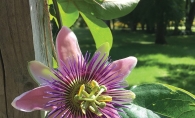
Spring ushers in all sorts of good things, especially budding trees and blooming flowers. But not all new plant life is necessarily good—take garlic mustard, for example. Classified as a restricted noxious weed in Minnesota, this biennial plant is highly invasive and inhibits other plants from growing. Luckily, though, garlic mustard is easy to both spot and remove, and spring is the best time to get rid of it.
Originally native to Europe, garlic mustard came to the U.S. via New York in the 19th century, likely used for food and medicinal purposes. It has since made its way across the country and has been in the upper Midwest for around 15 years. Though it typically invades woodlands and forested habitats, it can grow in either full shade or full sun, and the chemical emitted by its roots threatens native plants.
A single garlic mustard plant might produce up to 5,000 seeds, which can survive up to five years in the ground, so once it's established in an area, the plant can quickly and easily take over, disrupting natural habitats in the process. “It just spreads like wildfire,” says Samantha Muldoon, communications chair of the Lake Minnetonka Garden Club and a member of the Garden Club of America. “It can become a real problem, because it crowds out native plants, and it takes over.”
Thankfully, garlic mustard likewise proves easy to identify, especially during this time of year. Mary Morrison, horticultural chair of the Lake Minnetonka Garden Club, says that it in spring, garlic mustard begins to flower, looking similar to catnip, and plant parts emit a strong garlic odor when crushed. “It’s got shallow roots, but it travels underground and has these long stalks that then have white flowers in the spring.”
Though chemical solutions for killing garlic mustard do exist, Morrison says that they tend to be ineffective, especially because they kill native plant life alongside the weed. "What people tend to recommend is actual physical removal: digging or pulling it up by hand. Because it has shallow roots, it’s pretty easy to pull up and clear,” she says. Morrison says that mid to late May is typically the best time to pull. “The plants are out, and the flowers are out, so you can see exactly what you’re pulling—you’re not just pulling green plants.”
Be careful not to throw garlic mustard in your compost pile, though—pulled material can still spread seeds and invade other compost material, so garlic mustard should be treated as trash to avoid any inadvertent reseeding. And while it's dangerous to natural habitats, garlic mustard is edible. “It's a bitter green, and it's nutritious," Morrison says—so you might think about bringing some into your kitchen instead.
Each May, the Lake Minnetonka Garden Club hosts its Garlic Mustard Pull in Wofsfeld Woods. This year’s event will be held on Friday, May 18 in recognition of Endangered Species Day and the National Garden Club of America’s Partners for Plants program. Morrison says the event is a fun way for community members to collectively take action to help preserve the natural environment. For more information, visit the Lake Minnetonka Garden Club’s website here.
Garlic mustard information from the University of Minnesota Extension and the Minnesota Department of Agriculture.









